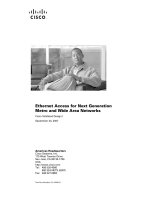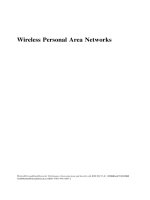Describe wireless wide area networks (WWANs) and how they are used
Bạn đang xem bản rút gọn của tài liệu. Xem và tải ngay bản đầy đủ của tài liệu tại đây (638.01 KB, 42 trang )
Wireless Communications
Wireless Wide Area Networks
Objectives
• Describe wireless wide area networks (WWANs) and
how they are used
• Describe the applications that can be used on a digital
cellular telephone
• Explain how cellular telephony functions
• List features of the various generations of cellular
telephony
• Discuss how satellite transmissions work
2
Cellular Telephone Applications
• Digital cellular telephones can be used to:
–
–
–
–
–
–
–
–
–
Browse the Internet
Send and receive short messages and e-mails
Participate in videoconferencing
Receive various sorts of information
Run a variety of business applications
Connect to corporate networks
Watch television or on-demand movies
Take and transmit pictures and short movies
Locate family members and employees using GPS
3
Cellular Telephone Applications
(continued)
• Short Message Services (SMS)
– One of the most widely used applications
– Allows for the delivery of short, text-based messages
between wireless devices
• Messages are limited to about 160 characters
– Applications
•
•
•
•
•
Person-to-person
Agent-to-person
Information broadcast services
Software configuration
Advertising
4
How Cellular Telephony Works
• Keys to cellular telephone networks
– Cells
• City cells measure approximately 10 square miles
• At the center of each cell is a cell transmitter connected
to a base station
• Each base station is connected to a mobile
telecommunications switching office (MTSO)
– Link between the cellular network and the wired
telephone world
– Controls all transmitters and base stations
5
How Cellular Telephony Works
(continued)
6
How Cellular Telephony Works
(continued)
• Keys to cellular telephone networks (continued)
– Transmitters and cell phones operate at low power
• Enables the signal to stay confined to the cell
• Signal at a specific frequency does not go far beyond the
cell area
– Same frequency can be used in other cells at the
same time
– Except in adjacent cells
• Cell phones have special codes
7
How Cellular Telephony Works
(continued)
8
How Cellular Telephony Works
(continued)
• When user moves within the same cell
– Transmitter and base station for that cell handle all of
the transmissions
• As the user moves toward the next cell
– A handoff process occurs
• Roaming
– User moves from one cellular network to another
9
How Cellular Telephony Works
(continued)
10
How Cellular Telephony Works
(continued)
11
First Generation Cellular Telephony
• First Generation (1G)
– Uses analog signals modulated using FM
– Based on Advanced Mobile Phone Service (AMPS)
•
•
•
•
•
Operates in the 800-900 MHz frequency spectrum
Each channel is 30 KHz wide with a 45 KHz passband
There are 832 frequencies available
Uses Frequency Division Multiple Access (FDMA)
FDMA allocates a single cellular channel with two
frequencies to one user at a time
• 1G networks use circuit-switching technology
12
Second Generation Cellular Telephony
• Second Generation (2G)
– Transmits data between 9.6 Kbps and 14.4 Kbps
• In the 800 MHz and 1.9 GHz frequencies
– 2G networks are also circuit-switching
– 2G systems use digital transmissions
– Digital transmission benefits
• Uses the frequency spectrum more efficiently
• Over long distances, the quality of the voice
transmission does not degrade
• Difficult to decode and offer better security
13
Second Generation Cellular Telephony
(continued)
• Second Generation (2G) (continued)
– Digital transmission benefits (continued)
• Digital transmissions use less transmitter power
• Enables smaller and less expensive individual receivers
and transmitters
• Multiple access technologies
– Time Division Multiple Access (TDMA)
– CDMA
– Global System for Mobile communications (GSM)
• Uses a combination of FDMA and TDMA technologies
14
2.5 Generation Cellular Telephony
• 2.5 Generation (2.5G)
–
–
–
–
Interim step between 2G and 3G
Operates at a maximum speed of 384 Kbps
2.5G networks are packet-switched
Advantages of packet switching
• Much more efficient
– Can handle more transmissions over a given
channel
• Permits an always-on connection
15
2.5 Generation Cellular Telephony
(continued)
• 2.5G network technologies
– General Packet Radio Service (GPRS)
• For TDMA or GSM 2G networks
• Uses eight time slots in a 200 KHz spectrum and four
different coding techniques
– Enhanced Data rates for GSM Evolution (EDGE)
• Can transmit up to 384 Kbps
• Based on a modulation technique called 8-PSK
– CDMA2000 1xRTT
• Operates on two 1.25 MHz-wide frequency channels
• Supports 144 Kbps packet data transmission
16
Third Generation Cellular Telephony
• Third Generation (3G)
– Intended to be a uniform and global standard for
cellular wireless communication
• Standard data rates
– 144 Kbps for a mobile user
– 386 Kbps for a slowly moving user
– 2 Mbps for a stationary user
• 3G network technologies
– CDMA2000 1xEVDO
• For 2.5G CDMA2000 1xRTT networks
17
Third Generation Cellular Telephony
(continued)
• 3G network technologies (continued)
– CDMA2000 1xEVDV will be the successor of
CDMA2000 1xEVDO
– Wideband CDMA (W-CDMA)
• For 2.5G EDGE networks
– High-Speed Downlink Packet Access (HSDPA)
• Beyond W-CDMA
• Uses a 5 MHz W-CDMA channel, variety of adaptive
modulation, multiple in multiple out (MIMO) antennas,
and hybrid automatic repeat request (HARQ)
18
Third Generation Cellular Telephony
(continued)
19
Third Generation Cellular Telephony
(continued)
20
Client Software
• Internet surfing or videoconferencing require client
software
– To operate on a wireless digital cellular device
• Common types of clients
–
–
–
–
WAP
i-mode
Java
BREW
21
Wireless Application Protocol (WAP
and WAP Version 2)
• Wireless Application Protocol (WAP) and WAP2
– Provide a standard way to transmit, format, and display
Internet data
• For devices such as cell phones
• WAP was developed in 1997
– Enables devices to send and receive Internet text-only
data
• WAP cell phone runs a microbrowser
– Uses Wireless Markup Language (WML) instead of
HTML
22
Wireless Application Protocol (WAP
and WAP Version 2) (continued)
23
Java
• Java programming language
– Developed by Sun Microsystems
– Object-oriented language used for general-purpose
business programming
• As well as interactive Web sites
• Java 2 Micro Edition (J2ME)
– Subset of Java specifically developed for programming
wireless devices
– Enables a cellular phone to access remote applications
and e-mail
• As well as run programs on the cellular phone itself
24
Binary Runtime Environment for
Wireless (BREW)
• BREW is a thin software environment
– Very small program that resides on a wireless device
• Capable of running applications that can be downloaded
by the device on demand
– BREW is compatible with Java, C, and C++
• BREW efficiently uses small amount of memory
– Occupies only a small amount of flash memory
– Dynamically allocates RAM for applications
• BREW can be used with other applications
25









